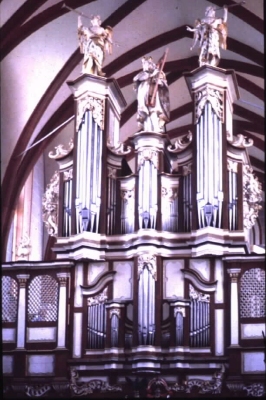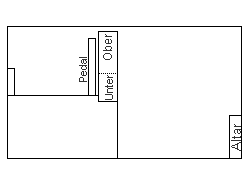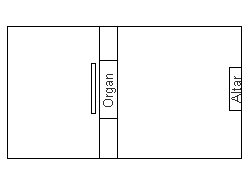  Altenberg
|
IntroductionThe Monastery of Altenberg is located about 50 miles north of Wiesbaden and Frankfort, in the Middle Rhine area of the western part of Germany. In fact, the Monastery overlooks the Lahn valley, a tributary of the Rhine. The Abbey Church is a venerable building, in which you can see traces of Medieval frescos that have been painted over but are now being restored. They were painted over largely because of the closing of the monastery and secularization of its buildings in 1802, a fate shared by many other such institutions during that time. The thirteenth-century buildings are now occupied by a group of Protestant nuns from East Prussia who are engaged primarily in social work. 162
Disposition
The sound of the organ is not powerful and solid, but elegant and chamber-like. The principals are bright and light in sound, having a more string-like quality than a flute-like sound. The principal chorus is bright and penetrating, but it isn't loud or dominating. The mixture is voiced to add a brightness to the sound of the principals without giving the chorus undue or inelegant force. The contrasting soft stops are among the most noteworthy sounds on the organ. String stops appeared first in organs of Central and Southern Germany, a generation or so before this organ was built, so the concept of a string sound from open pipes was well-developed and accepted by the time these were made. The Viola da gamba is very quiet, with a quality that sounds more like a Renaissance Viol than a modern Violin. The speech is not quick, like that of a nineteenth or twentieth-century string, but slow, with a pronounced transient that leads to the sustained tone of each note. The 4' Salicional sounds more like a soft principal than strings you might hear on a twentieth-century organ built in the United States. The string stops of the Hauptwerk can be combined to form a particularly delicate and luminous-sounding string chorus, an usual feature on any organ of this period. The various flute stops stand in contrast to the strings by virtue of the quality of their sustained tone, but they too have an essential delicacy. The Gedackt is softer than one you would find on a North German organ, and its strength is mirrored in that of the other flutes, which are also softer than you would find on many other instruments. Their quiet sound is not without character and distinct personality, though. The Rohrflaut is quite distinct from the Flaut Travers, which has a soft, slow speech that is reminiscent of that of the string stops. The strength of the sound of this organ - - its "force," if you will - - comes from the reeds, which are made somewhat in the style of French reeds of a generation or so earlier. The Trompette is the primary chorus reed, and it gives strength to the sound when it is added to the principal chorus. The Vox humana is not unlike the Cromornes of nearby Alsace in its penetrating quality and soft sound. The Pedal Posaune is round and full, neither dull nor obtrusive; its resonators are wooden. © 2000 AD James H. Cook |
||||||||||||||||||||||||||||||||||||||||||||||||||||||||||||||||||||||||||||||||||||||||||||
 The organ was built in 1757 by Johann Wilhelm Schöler of Bad Ems. It was not used for over a century after the monastery was closed, but was restored in 1976 by Gebr. Oberlinger of Windesheim. In some ways it is typical of German organs of the period in that it has two manual divisions and a small pedal, whose pipes are located behind the main case. The placement of the two manual divisions is a little unusual, however. In the photograph to the right, you can see a divided case and what looks like two divisions that appear to be Hauptwerk and Rückpositiv - - called Oberwerk and Unterwerk in this instrument. If you look closely, you will see that the space you might expect to separate the two cases is not there. The two case fronts occupy the same vertical plane and are, in fact, placed one over the other. Furthermore, if you look at the ceiling above the organ, you can see that the space behind the organ is quite large, extending for some distance from the case.
The organ was built in 1757 by Johann Wilhelm Schöler of Bad Ems. It was not used for over a century after the monastery was closed, but was restored in 1976 by Gebr. Oberlinger of Windesheim. In some ways it is typical of German organs of the period in that it has two manual divisions and a small pedal, whose pipes are located behind the main case. The placement of the two manual divisions is a little unusual, however. In the photograph to the right, you can see a divided case and what looks like two divisions that appear to be Hauptwerk and Rückpositiv - - called Oberwerk and Unterwerk in this instrument. If you look closely, you will see that the space you might expect to separate the two cases is not there. The two case fronts occupy the same vertical plane and are, in fact, placed one over the other. Furthermore, if you look at the ceiling above the organ, you can see that the space behind the organ is quite large, extending for some distance from the case. The diagram to the right shows a cross-section of the room. The organ is placed at the front of a gallery that is quite deep, and there is a small chapel there behind the organ. As you can see, the two manual divisions are located directly over one another, with the pedal behind.
The diagram to the right shows a cross-section of the room. The organ is placed at the front of a gallery that is quite deep, and there is a small chapel there behind the organ. As you can see, the two manual divisions are located directly over one another, with the pedal behind.